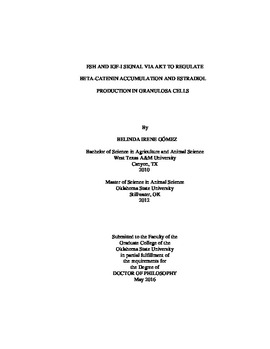| dc.contributor.advisor | Hernandez Gifford, Jennifer A. | |
| dc.contributor.author | Gomez, Belinda Irene | |
| dc.date.accessioned | 2017-02-22T22:09:17Z | |
| dc.date.available | 2017-02-22T22:09:17Z | |
| dc.date.issued | 2016-05 | |
| dc.identifier.uri | https://hdl.handle.net/11244/48806 | |
| dc.description.abstract | Estradiol is the female sex hormone that profoundly influences the female reproductive system from puberty to fertility. Circulating estradiol in women is synthesized primarily by ovarian granulosa cells in response to the pituitary glycoprotein follicle-stimulating hormone (FSH). In granulosa cells FSH triggers a signaling cascade that subsequently induces expression of aromatase (Cyp19a1), a steroidogenic enzyme that catalyzes the aromatization of testosterone into estradiol. While FSH stimulates estradiol production, estradiol concentrations are regulated by intra-ovarian signaling molecules wingless-type mammary tumor virus integration-site (WNT) family molecules and insulin-like growth factor-I (IGF-I). Intracellular signaling cascades elicited by FSH, WNT, and IGF-I eventually overlap at beta-catenin, a transcription co-factor. In granulosa cells beta-catenin accumulates in response to FSH, and WNT, and is required for Cyp19a1 expression. Although it is evident that granulosa cells require beta-catenin to maintain estradiol production, there is still much to be identified about its role, regulators, and downstream effectors. In this dissertation, evidence is presented that enhances our understanding of the complex intracellular regulation of estradiol biosynthesis. Data demonstrates beta-catenin accumulation in response to FSH and IGF-I occur via phosphatidylinositol-3 kinase (PI3K)/protein kinase B (AKT) pathway as inhibition of PI3K signaling reduced beta-catenin and estradiol concentrations. Additionally, IGF-I rescued FSH-mediated Cyp19a1 expression and estradiol production from the inhibitory effects of WNT3A. To elucidate the mechanism, beta-catenin accumulation, phosphorylation status of beta-catenin and Forkhead box O protein were analyzed by Western blot and Axin2 mRNA expression by real-time PCR. Data indicates IGF-I did not modulate expression of the above mentioned target markers and therefore was ruled out as potential mechanisms. A noteworthy discovery was in comparing animal models and identifying bovine but not rat granulosa cells have increased beta-catenin accumulation with IGF-I treatment which further adds to the complex nature of estradiol production. In the final study it was confirmed that the crucial mechanism by which beta-catenin regulates Cyp19a1 transcription is through its association with T-cell Factor on the promoter. Together, these data provide a new appreciation and understanding of the complex regulation of beta-catenin in estradiol production. | |
| dc.format | application/pdf | |
| dc.language | en_US | |
| dc.rights | Copyright is held by the author who has granted the Oklahoma State University Library the non-exclusive right to share this material in its institutional repository. Contact Digital Library Services at lib-dls@okstate.edu or 405-744-9161 for the permission policy on the use, reproduction or distribution of this material. | |
| dc.title | FSH and IGF-I signal via AKT to regulate beta-catenin accumulation and estradiol production in granulosa cells | |
| dc.contributor.committeeMember | DeSilva, Udaya | |
| dc.contributor.committeeMember | Zhang, Guolong | |
| dc.contributor.committeeMember | Thompson, Penny | |
| osu.filename | Gomez_okstate_0664D_14652.pdf | |
| osu.accesstype | Open Access | |
| dc.type.genre | Dissertation | |
| dc.type.material | Text | |
| thesis.degree.discipline | Animal Science | |
| thesis.degree.grantor | Oklahoma State University | |
